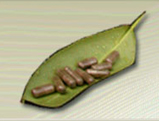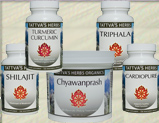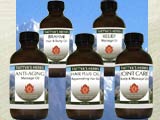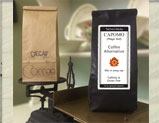 Loading... Please wait...
Loading... Please wait...Save 20% Storewide
Discount At Check Out
THE THERAPEUTIC PROPERTIES AND USAGES OF FIVE COMMON SPICES: CORIANDER, CUMIN, FENNEL, GINGER, AND TURMERIC
Posted by Mark L. Vinick, D.C., C.A.S. on 28th Dec 2009
Clinical Ayurvedic Specialist (C.A.S.)
Board Certified, American Academy of Pain Management
Board Certified, American Board of Anti-Aging Health Practitioners
INTRODUCTION
Spices have been revered throughout history and around the world for their culinary enhancing and medicinal properties. Over 4,500 years ago, the Chinese emperor Shen Nung composed an extensive treatise on medicinal herbs and spices. Around the same time in the Indus Valley in India, the science of Ayurveda developed. Both of these ancient traditions held that herbs and spices contain healing properties, and that the knowledge of their proper application and usage was of divine origin. Around 300 years B.C., the Egyptian school of medicine
in Alexandria accumulated a large body of medical knowledge, well over 700,000 books. All of which were unfortunately burned and destroyed in the fourth century A.D. by religious fanatics. The Greek system of medicine was also established around 300 B.C. It was in that period that Hippocrates, considered the father of modern medicine, produced his Materia Medica, in which he carefully described many herbal medicines still in use today.
In the first century A.D., Dioscorides, the personal physician to Emperor Nero, published his book, De Materia Medica, which detailed the use of over five hundred medicinal herbs. His work became the standard text of the medicinal use of herbs throughout the Middle Ages. Towards the end of the fifteenth century, Christopher Columbus ventured to find a shortcut to India, in an attempt to bring the much in demand Indian spices to Western Europe. In doing so, he accidentally discovered the New World, the North American Continent, which also contained thousands of previously unknown botanicals. Early Native American cultures also possessed a rich knowledge of the medicinal and healing properties of many botanical herbs and plants.1
Ayurveda, the Science of Life, which is the ancient traditional system of medicine from India, believed to be well over 5000 years old, has particularly emphasized the subtle, and yet, incredible healing properties of herbs and
2
spices that are readily available and can be used on a daily basis.
The following five easily obtainable spices are possibly some of the best sources of botanical healing available today.
CORIANDER
Coriandrum sativum
Scientific, and western properties and usage’s:
Coriander is native to many areas throughout the world. It is found in North and South America. The medicinal parts of the plant are the oil, and the dried ripe fruit. It consists of Volatile oils, which make up .4 to 1.7% of its total volume. The chief components being: coriandrol, borneol, p-cymene, camphor, geraniol, limonene, and alpha-pinene. The characteristic bug like smell is due to the trans-tridec-2-enale content. Its Fatty oil content makes up 13 to 21% of its total volume. The chief fatty acids being: Petroselic acid, oleic acid, and linolenic acid. It also contains Hydroxycoumarins, including umbelliferone, and scopoletin.
The essential oil of coriander has been shown to stimulate secretion of gastric juices, and as such is useful as a carminative and spasmolytic agent. In vitro, it contains antibacterial and antifungal properties.
Coriander has been reviewed and approved by the German Regulatory Authority’s agency, “Commission E”. This agency has assessed peer-reviewed literature on over 300 common botanicals. Their conclusions are recognized as the foremost expert consensus on medicinal herbs available. They have approved coriander for general use for loss of appetite, and dyspepsia. Unproven folk medicine remedies include: digestive and gastric complaints, chest pain,
upper abdominal pain, bladder infections, rashes associated with leprosy, fever, dysentery, as an external poultice for headache, oral and pharyngeal complaints, uncomplicated halitosis, and in post partum recovery.
Health risks, or other side effects have not been reported with proper administration of therapeutic dosages. Coriander has been shown to have a weak sensitization effect. The recommended dosage is one gram, three times a day. If taken as a tincture, the recommended dose is 10 to 20 drops after meals. 2
Ayurvedic properties and usage’s:
3
The Sanskrit name for Coriander is Dhanyaka. In Traditional Chinese Medicine it is known as Yan shi. The parts
used are the oil, fresh fruit, and fresh plant, which is also known as cilantro, or Chinese parsley.
The energetics of Coriander are as follows: Its taste (rasa) is bitter and pungent. Its energy (virya) is cooling, and its post digestive effect (vipaka) is pungent. It is decreasing to all three doshas, although if the fresh leaves of the plant are used, its effect is decreasing to pitta and kapha, while neutral to vata. The spice specifically effects the digestive, respiratory, and urinary systems. Its actions are: alterative, diaphoretic, diuretic, carminative, and stimulant. It has proven useful in conditions of: burning urethritis, cystitis, urinary tract infection, urticaria, rash, burns, sore throat, vomiting, indigestion, allergies, and hay fever. There are few precautions for its use, except for high Vata, especially Vata in the nerve tissue (majja dhatu). It is prepared either as a cold or hot infusion, or by taking it in powder form of 250 to 500 mg, or the fresh juice of the fresh plant (cilantro). 3,4
“ Coriander seeds are a good household remedy for many Pitta disorders, particularly those of the digestive tract or urinary system. It is an effective digestive agent for Pitta conditions in which most spices are contraindicated or used with caution. The fresh juice of the herb is effective internally for allergies, hay fever and skin rashes; one teaspoon three times a day, but it can also be used externally for itch and inflammation.” 3 (p. 114)
CUMIN
Cuminum cyminum
Scientific, and western properties and usage’s:
Cumin is native to northern Egypt and Turkey. Today it is cultivated in the Mediterranean region, Iran, Pakistan,
China, India, South America, and the United States. The medicinal parts of the plant are the dried ripe fruit, and the oil. It consists of Volatile oils, which make up 2 to 5% of its total volume. The chief components being:
Cuminaldehyde, gamma-terpenes, beta-pines, p-cymene, and 1,3-p-menthandial. Its Fatty oil content makes up 10 to 15% of its total volume. The chief fatty acids being: petroselic, and palmitic acids. Its Proteic content is between 15 to 20%.
Cumin has demonstrated antimicrobial effects. It has been shown to retard the growth of mycelium, and toxin, or afla-toxin production in Aspergillus ochraceus, C. versicolor, and C. flavus. Cumin has also shown beneficial
4
mutagenic and blood-clotting effects. Other effects include: estrogenic, antispasmodic, diuretic, aphrodisiac, carminative, stimulative, and analgesic. Unproven folk medicine remedies include: usefulness as a carminative,
and for diarrhea and colic, both in the human population, and in veterinary medicine.
Health risks, or other side effects have not been reported with proper administration of therapeutic dosages.
Both internal and external modes of administration are applicable. The recommended single dosage is 300 to 600 mg of dried herb, which equals approximately 5-10 fruits.2
Ayurvedic properties and usage’s:
The energetics of Cumin are as follows: Its taste (rasa) is pungent and bitter. Its energy (virya) is slightly warming, and its post digestive effect (vipaka) is pungent. It decreases both Vata and Kapha, and does not overly increase Pitta. Cumin is used as a stimulant, carminative, diuretic, and lactagogue. It is also used in overcoming diarrhea and dysentery, when mixed with yogurt and water. It is especially useful for abdominal pain and distention. As it is useful in reducing abdominal gas, it is an aid to digestion and absorption, and helps to counter the effects of heavy foods, such as cheese, yogurt, beans, potatoes, or overeating. It is also used as an antidote for tomatoes, chilies, and other hot, pungent foods. Its qualities and usage are very similar to coriander and fennel, with which it is commonly used. 3,4
FENNEL
Foeniculum vulgare
Scientific, and western properties and usage’s:
Fennel is native to the Mediterranean region. Today it is found cultivated in England, Germany, South Tyrol, Argentina, Iran, China, and India. The medicinal parts of the plant are the oil, the dried ripe fruit, and the seeds.
It consists of Volatile oils such as: Trans-anethols, Fenchone, and Estragole. Their percentages vary depending upon whether the extraction is from the fennel oil, or the seeds. Additional Volatile oils found in smaller percentages include: alpha-pinenes, camphene, p-cymene, myrcene, limonene, alpha and beta-phellandrene, gamma-terpenes, terpinols, gamma-fenchen. Traces of hydroxycoumarins, such as umbelliferone, scopoletine, osthenol, scoparin, and
5
traces of furocoumarins, such as bergapten, columbianetin, psoralen, and xanthotoxin are also present. In addition, Pyranocoumarins, Flavonoids, and Fatty oils are also present.
The seed has been shown to stimulate gastrointestinal motility. It has demonstrated an antispasmodic effect in higher concentrations. Fennel has been reviewed and approved by Commission E for: cough, bronchitis, and indigestion. Unproven folk medicine remedies include: mild spastic discomfort of the gastrointestinal tact, feeling of overfullness, flatulence, and upper respiratory tract colds.
Health risks, or other side effects have not been reported with proper administration of therapeutic dosages. Allergic reactions to Fennel are very rare. Individuals with an allergy to celery are more at risk for such hypersensitivities. The recommended dosage for the oil is 0.1 to 0.6 ml per day, and of the seed is 5 to 7gm per day.2
Ayurvedic properties and usage’s:
The Sanskrit name for Fennel is Shatapushpa, meaning that which possessed a hundred flowers. In Traditional Chinese Medicine it is known as Xiao hue xiang. The parts used are the oil, the fruit, and its seeds. The energetics of Fennel are as follows: Its taste (rasa) is sweet and pungent. Its energy (virya) is slightly cooling, and its post digestive effect (vipaka) is sweet. It is tridoshic, i.e. decreasing to all three doshas. Fennel specifically effects the digestive, urinary, and nervous systems. It is believed to act on several tissues of the body: lymph, plasma (rasa), blood, (rakta), muscle (mamsa), bone marrow, and nervous tissue (majja). Its actions are: carminative, antispasmodic, stomachic, stimulant, and diuretic. It has proven useful in conditions of: indigestion, abdominal pain, including cramps and gas, diminished agni, difficult and/or burning urination, and colic, esp. in children.
There are no known precautions for its use. It is prepared either as a infusion with 250 to 500 mg, or the roasted seeds may be chewed after meals, as a digestive aid. Fennel seeds are considered one of the most balanced and sattvic of all spices. 3,4
“ Fennel seeds are one of the best herbs for digestion, strengthening agni without aggravating pitta, stopping cramping and dispelling flatulence. They can be taken roasted after meals, one teaspoon, by themselves or with rock salt. They combine well with cumin and coriander as three cooling spices. Fennel seeds are excellent for digestive weakness in children or in the elderly. They are calming to the nerves, their aroma acts upon the mind and promotes
6
mental alertness. For urinary problems, they combine well with coriander. Fennel can be used for digestive weakness where hot spices and peppers might overheat or overstimulate. They work to stop the griping of purgatives and can help promote menstruation and to promote milk flow for nursing mothers.” 3 (p. 117)
GINGER
Zingiber officinale
Scientific, and western properties and usage’s:
Ginger is native to southeastern Asia. It is today found cultivated in the U.S., China, India, the West Indies, and tropical areas. The medicinal part of the plant is the root. The root consists of Volatile oils, which make up 2.5 to 3.0% of its total volume. The chief components being: zingiberene, arcurcumene, beta-bisabolene, ar-curcumene, neral, geranial, D-camphor, beta-phellandrene, linalool, and (E)-alpha-farnesene. Their percentages vary considerably, dependent upon the country of origin. Aryl alkanes, including Gingerols, and Shogaols, and the Gingerdiol, Diarylheptanoids are also present. Ginger root consists of approximately 50% starch.
Ginger has been studied extensively in both in vitro and animal studies. Its effects are numerous. They include:
Anti-emetic, anti-inflammatory, anti-oxidant, antithrombotic, anti-migraine, anti-lipidemic and immune system stimulating effects. In addition, ginger has been shown to promote salivary, gastric, and bile secretions. Most anti-emetic medications produce their effects while acting on the CNS. It is believed that Ginger produces its effect by acting on the gastrointestinal tract itself. It increases both the tone, and the peristaltic activity of the intestine. 2
“One double-blind, randomized, non-placebo controlled study compared the effectiveness of Ginger and six other commonly used non-herbal drugs (scopolamine, dimenhydrinate with caffeine, cyclizine, cinnarizine, cinnarizine with domperidone, meclizine with caffeine) in 1489 participants during whale-watching voyages off the coast of Norway. 78.3% of those that took 500 mg of Ginger root 2 hours prior to a boat trip were symptom-free for the 6-hour duration. The incidence of severe vomiting did not differ in a statistically significant way between Ginger and any of the other test groups.” 2 (p. 339)
7
In another study, “A double-blind, placebo-controlled study involving 120 females that underwent gynecologic outpatient surgery was performed. The participants were randomly given either 1 gm of powdered Ginger root or 10 mg of metoclopramide orally and evaluated for incidence of postoperative nausea and vomiting. Ten percent of the patients in the Ginger group had one or more episodes of vomiting. 17.5% of the metoclopramide arm and 22.5% of the placebo group had one or more episodes of vomiting. Fifteen percent of the Ginger group and 32.5% of the metoclopramide group required antiemetic treatment compared to 37.5% of the placebo group. The authors concluded that the Ginger group had a statistically significant lower incidence of nausea and vomiting when compared to placebo.” 2 (p. 340)
Ginger has been reviewed and approved by Commission E for: loss of appetite, travel sickness, and indigestion. Unproven folk medicine remedies include: carminative, and expectorant. Traditional Chinese Medicine uses ginger in the treatment of colds, nausea, and vomiting.
Health risks, or other side effects have not been reported with proper administration of therapeutic dosages.
Although the German Commission E recommends ginger not be used for morning sickness associated with pregnancy, several studies confirm the effectiveness and safety of its use by pregnant women. Common sense would dictate that excessive doses be avoided in this situation. As ginger does have a cholagogic effect, its usage should be restricted in individuals with known gallstone disease. Individuals who are risk for hemorrhage should not use ginger, due to its inhibition of thromboxane synthesis. Ginger has been reported to create hypersensitivity reactions producing dermatitis. Large overdoses of Ginger can lead to depression of the central nervous system, and also cardiac arrhythmias. As Ginger does have antithrombotic qualities, those with bleeding disorders should avoid large dosages. Ginger consumption on an empty stomach should be limited to 6 grams, as this amount of the powered root has demonstrated increased exfoliation of gastric surface epithelial cells in humans, and as such, may lead to ulcer formation. The recommended dosage for most conditions is 0.5 to 4 grams per day, taken in divided dosages. 2
Ayurvedic properties and usage’s:
The Sanskrit name for Ginger is Sunthi, or Nagara, in its dry form, and Ardraka for fresh Ginger. In traditional Chinese Medicine it is known as Gan jiang, dry, and Shen jiang, fresh. The rhizome is the part of the plant that is
8
used medicinally. The energetics of Ginger are: Its taste (rasa) is pungent and sweet. Its energy (virya) is heating, and its post digestive effect (vipaka) is sweet. It decreases Vata and Kapha, while increasing Pitta. Ginger specifically effects the digestive and respiratory systems. Its actions are: carminative, stimulant, diaphoretic, expectorant, anti-emetic, and analgesic. It has proven useful in conditions of: indigestion, belching, abdominal pain, colds, flu, laryngitis, arthritis, hemorrhoids, heart disease, and for headache. Ginger should be used cautiously in cases of high fever, bleeding, ulcers, or inflammatory skin conditions. Ginger is prepared either as an infusion, decoction, in powder form of 250 to 500 mg, or by using the fresh juice.3,4
“ Ginger is perhaps the best and most sattvic of the spices. It was called vishwabhesaj, the universal medicine. As such, it was prepared by adding fresh ginger juice to ginger powder, mixing it in a mortar and pestle until it became a thick jam, whereupon it was rolled into pills. The proportion of juice to powder was upwards of 4 to 1. Two pills, about the size of a pea, were taken three times a day. With honey, Ginger relieves Kapha, with rock candy it relieves Pitta, with rock salt it relieves Vata.
Dry Ginger is hotter and drier than fresh. It is a better stimulant and expectorant for reducing Kapha and increasing Agni. Fresh Ginger is a better diaphoretic, better for colds, cough, vomiting, and for deranged Vata.
The uses of Ginger in digestive and respiratory diseases are well known. It is also good in arthritic conditions and it is tonic to the heart. It relieves gas and cramps in the abdomen, including menstrual cramps due to cold. Externally, it makes a good paste for pain and headaches.” 3 (p. 121)
The Chopra Center recommends several useful ways to benefit from the therapeutic qualities of Ginger.
“Our recipe for Ginger tea uses one teaspoon of grated root per pint of hot water. If the tea is a little too pungent for you, try adding a teaspoon of shredded or chopped licorice root along with the ginger. When used as an externally applied substance, obtain the fresh juice by removing the outer fibrous layer and putting the inner part of the root through a juicer. Then mix equal parts of the ginger juice with a carrier oil such as almond or sesame, and massage into the sore muscle or joint. To relieve a migraine, mix a tablespoon of dry powder with a few drops of hot water until it is the consistency of a paste, then apply to your forehead and temples and sit in a warm bath”. 1(p. 205)
9
TURMERIC
Curcuma domestica
Scientific, and western properties and usage’s:
Turmeric is native to India. It is found today cultivated in India and other parts of southeast Asia. The medicinal part of the plant is the dried and cooked rhizome. The root consists of Volatile oils, which make up 3-5% of its total volume. The chief components being: alpha and beta-tumerone, artumerone, alpha and gamma-atlantone, curlone, zingiberene, and curcumol. It also contains Curcuminoids, which conprise 3-5% of its total volume. These consist of: curcumin, demethoxy curcumin, and bidemethoxy curcumin. It also contains: 1,5-diaryl-penta-1,4-dien-3-one derivatives, and also Starch, which comprises approximately 30-40% its total volume.
Turmeric has been found to have many useful therapeutic qualities, including: anti-oxidant, anti-tumoral, anti-microbial, anti-inflammatory, anti-hepatotoxic, anti-hyperlipidemic, and insect repellent effects.
Much recent research has been devoted to the beneficial qualities of Turmeric. It has been shown to have more
DNA protective qualities than the antioxidants beta carotene and vitamin E. It has been shown to stimulate the production of the cancer protective and detoxifying enzyme, glutathione S-transferase. It improves the anti-cancer, and anti-inflammatory properties of nitric oxide. It has powerful anti-inflammatory, and anti-ulcerative properties, orally, and topically. It serves to amplify the anti-cancer properties of other phytonutrients. It inhibits the growth of leukemia in the stages of initiation, promotion, and progression. It inhibits precancerous colon growths, suppresses colon cancer, oral tumors, multiple lines of breast cancer, and inhibits skin cancer growth when applied topically. In addition, it has been shown to enhance metabolism, help the body reduce undesirable fatty deposits, and protect against heart disease by reducing inflammatory causing bacteria in the blood circulation.
Turmeric has been reviewed and approved by Commission E for: loss of appetite, and indigestion.
Unproven folk medicine remedies include: indigestion, abdominal distention due to gas, feeling over full secondary to overeating, diarrhea, intermittent fever, bronchitis, colds, edema, worms, leprosy, inflammation of the kidney, cystitis, headache, flatulence, chest infections, colic, and amenorrhea. Externally, it has been used to help speed the healing of bruises, leech bites, infected wounds, eye infections, inflammation of the oral mucosa, and inflammatory
10
skin conditions. Traditional Chinese Medicine has found Turmeric useful for pains in the abdomen, liver, stomach, and chest. In addition, it is used for heat stroke, nose bleeds, and vomiting with associated bleeding.
Health risks, or other side effects have not been reported with proper administration of therapeutic dosages.
Turmeric should not be used during pregnancy due to its reported antifertile effects. It is also contraindicated for those with diagnosed gall bladder disease. The recommended dose is 1.5 to 3 grams of the powder per day taken in divided doses 2 to 3 times a day, after meals. If taken as a tea, 2 to 3 cups per day, between meals is recommended. If taken as a tincture (1:10 strength), the recommended dose is 10 to 15 drops, 2 to 3 times per day. 2
Ayurvedic properties and usage’s:
The Sanskrit name for Turmeric is Haridra. In Traditional Chinese Medicine it is known as Jiang huang. The part that is used medicinally is the rhizome. The energetics of Turmeric are as follows: Its taste (rasa) is bitter, astringent, and pungent. Its energy (virya) is heating, and its post digestive effect (vipaka) is pungent. It is decreasing to Kapha, and can be increasing to Pitta and Vata, if taken in excess. Turmeric specifically effects the digestive, respiratory, and circulatory systems. Its actions are: carminative, alterative, stimulant, antibacterial, and vulnerary. It has proven useful in conditions of: indigestion, sore throat, cough, skin conditions, poor circulation, amenorrhea, diabetes, arthritis, anemia, and in wound and bruise healing. Turmeric should be used cautiously in
acute jaundice, hepatitis, and in pregnancy. It is prepared as an infusion, decoction, milk decoction, or by taking it in powder form of 250mg to 1 gram. 3,4
“Turmeric is an excellent natural antibiotic, while at the same time it strengthens digestion and helps improve intestinal flora. As such it is a good antibacterial for those chronically weak or ill. It not only purifies the blood, but also warms it and stimulates formation of new blood tissue.
Turmeric gives the energy of the Divine Mother and grants prosperity. It is effective for cleansing the chakras (nadi-shodhana), purifying the channels of the subtle body. It helps stretch the ligaments and is, therefore, good for the practice of hatha yoga.
Turmeric promotes proper metabolism in the body, correcting both excesses and deficiencies. It aids in the digestion of protein.
11
Externally, it can be used with honey for sprains, strains, bruise or itch. It is tonic to the skin, for which purposes it can be taken internally as a milk decoction.” 3(p. 150)
MAXIMIZING THE BENEFITS OF SPICES
Now that we have reviewed the beneficial effects of these spices, the obvious next step is to determine the best way of incorporating them into our daily diet so we may maximize their qualities and enhance our health. The following spice formula is an excellent and appetizing way to accomplish this. In fact, we may find that many of the vegetables that we know we should be eating, but don’t because we have never enjoyed their taste, actually taste better with this flavor enhancing spice blend. In fact, combining the spices with vegetables actually enhances the beneficial properties of both.
Dr. R.K. Mishra’s Immunity Mix Spice Blend
Ingredients:
6 parts ground turmeric
6 parts ground fennel
3 parts ground cumin
3 parts ground coriander
1 part powdered dry ginger
1 part ground black pepper
¼ part ground cinnamon
Directions:
Mix the spices together well and store in an airtight container in a cool place, and away from direct sunlight.
Since spices contain both lipid and water soluble nutrients, in order to derive benefit from both fractions, one needs
a combined approach to maximize both types of nutrients. To get the full benefit from the water-soluble nutrients,
mix ½ teaspoon of the spice blend with vegetable soup, or one can add it to vegetables as they are cooking. If you
are eating out, or not cooking your own food, you can at least sprinkle the blend over the already prepared food at
the table. To get the full benefit from the lipid-soluble nutrients, heat 1 tablespoon of Ghee (clarified butter), on
medium heat until it melts completely. Then mix in ½ teaspoon of the spice blend and heat a few minutes until the
12
aroma is released, being careful not to burn the spice. Then you can either add this spiced ghee to any other
dish just before serving, or instead, one can add veggies, rice, dahl, etc. to the mixture and cook for a few minutes,
and then add enough water and continue cooking until done. 5
REFERENCES:
1 Chopra, Deepak, and David Simon, THE CHOPRA CENTER HERBAL HANDBOOK, New York, N.Y.: Three Rivers Press, 2000.
2 Physicians Desk Reference, PDR FOR HERBAL MEDICINE, Montvale, N.J: Thomson Medical Economics, 2000.
3 Frawley, David, and Vasant Lad, THE YOGA OF HERBS, Santa Fe, New Mexico: Lotus Press, 1988.
4 Sharma, R.K., and Bhagwan Dash, CARAKA SAMHITA, translation, Varanasi, India: Chowkhamba Sanskrit Studies, 1997.
5 Sharma, Hari, and Rama K. Mishra, THE ANSWER TO CANCER, New York, N.Y.: SelectBooks, Inc., 2002.















